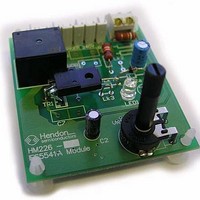HM226-T Hendon Semiconductors, HM226-T Datasheet - Page 7

HM226-T
Manufacturer Part Number
HM226-T
Description
Switch Modules & Development Tools IES5541A demoboard Sensor Input Control
Manufacturer
Hendon Semiconductors
Datasheet
1.HM226-T.pdf
(15 pages)
Specifications of HM226-T
Description/function
Relay Switch Demo Board
Board Size
70 mm x 61 mm
Maximum Operating Temperature
+ 70 C
Minimum Operating Temperature
0 C
Supply Current
10 A
For Use With/related Products
IES5541A
Lead Free Status / RoHS Status
Lead free / RoHS Compliant
6
The HM226 Relay switching module with contact
protection provides a general purpose platform for relay
control of loads up to 10A. The relay can be triggered by a
NTC (negative temperature coefficient) thermistor or an
external digital logic source. The HM226 is designed
around the IES5541A IC and uses a triac to prevent arcing
of the relay contacts during switching to extend the relay
lifetime.
Two options for controlling the HM226 are included in the
design. An NTC can be used to provide an input to the
module in order to switch the relay. Alternatively a digital
input from such devices as a microcontroller or FPGA (field
programmable gate array) can be used to control the
switching of the load. These control options suit a wide
variety of applications in heating element control and the
home appliance market.
The HM226 can accommodate a wide temperature sense
range. To vary the range the designer only needs alter the
resistor values in the temperature sensing part of the
circuit. For more accurate temperature control, circuitry
can be included external to the HM226. The NTC chosen
will also affect the range and sensitivity of the HM226.
A relay driven load is preferable to a triac driven load in
situations where heat dissipation is an issue. A triac
switching a 10A load requires a large heatsink and may
need to be mounted remotely from the PCB. A relay can
switch a 10A load with no heat dissipation issues, allowing
it to be mounted on the PCB to provide a more compact
device.
A relay’s main drawback is the arcing that can occur
between the contacts of the relay during switching. This
leads to burning, pitting and increased resistance,
eventually leading to failure of the contacts.
The HM226 all but eliminates arcing of the relay contacts.
The IES5541A provides a means for protecting the relay
contacts during switching using a small inexpensive triac.
When the IES5541A senses the first signs of arcing across
the relay contacts during relay open/close, the triac is fired.
The triac is also refired 8 times at regular intervals for four
full mains cycles when the relay is closed. For a mains
frequency of 50Hz for example, this time window where
the triac may be triggered will be 80ms.
The HM226 consists of the basic HM226 printed circuit
board and comes preasembled with all the components
required to implement a logic controled switch function.
2007 Dec 11, Revision 5.0
FUNCTIONAL OVERVIEW
7
Protected Relay Switching Module
6.1
The HM226 contains a relay driver with contact protection
IC (IC1); the IES5541A. The module is designed to
showcase the relay contact protection that is offered by the
IES5541A in constant switching applications. In its most
common applications a load is thermostatically controlled
by the module using an external NTC as the temperature
sensor.
The HM226 uses an inexpensive low coil voltage DC relay
rather than an AC driven relay. A network of diodes,
resistors and capacitors allow the DC relay to be switched
using a SCR from AC mains.
Although the triac may carry the load current during
switching the heat dissipated in the triac is not significant
in this application as the triac only conducts the load
current for very short periods of time during relay opening
and closing operations.
For a detailed description of the functioning of the
IES5541A integrated circuit refer to the Data Sheet
“IES5541A Relay Driver with Contact Protection”.
Technical background
Engineering Sample Information
HM226 - L / T
















